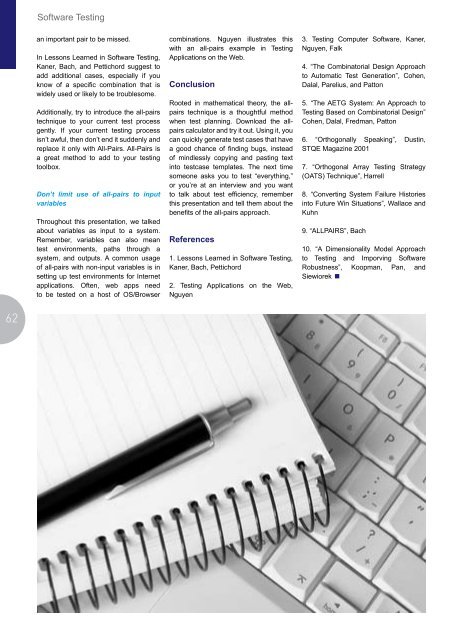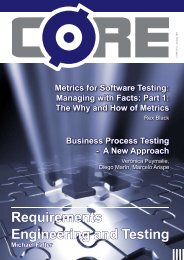Comparison of Change Management Systems
Comparison of Change Management Systems
Comparison of Change Management Systems
You also want an ePaper? Increase the reach of your titles
YUMPU automatically turns print PDFs into web optimized ePapers that Google loves.
62<br />
S<strong>of</strong>tware Testing<br />
an important pair to be missed.<br />
In Lessons Learned in S<strong>of</strong>tware Testing,<br />
Kaner, Bach, and Pettichord suggest to<br />
add additional cases, especially if you<br />
know <strong>of</strong> a specific combination that is<br />
widely used or likely to be troublesome.<br />
Additionally, try to introduce the all-pairs<br />
technique to your current test process<br />
gently. If your current testing process<br />
isn’t awful, then don’t end it suddenly and<br />
replace it only with All-Pairs. All-Pairs is<br />
a great method to add to your testing<br />
toolbox.<br />
Don’t limit use <strong>of</strong> all-pairs to input<br />
variables<br />
Throughout this presentation, we talked<br />
about variables as input to a system.<br />
Remember, variables can also mean<br />
test environments, paths through a<br />
system, and outputs. A common usage<br />
<strong>of</strong> all-pairs with non-input variables is in<br />
setting up test environments for Internet<br />
applications. Often, web apps need<br />
to be tested on a host <strong>of</strong> OS/Browser<br />
combinations. Nguyen illustrates this<br />
with an all-pairs example in Testing<br />
Applications on the Web.<br />
Conclusion<br />
Rooted in mathematical theory, the allpairs<br />
technique is a thoughtful method<br />
when test planning. Download the allpairs<br />
calculator and try it out. Using it, you<br />
can quickly generate test cases that have<br />
a good chance <strong>of</strong> finding bugs, instead<br />
<strong>of</strong> mindlessly copying and pasting text<br />
into testcase templates. The next time<br />
someone asks you to test “everything,”<br />
or you’re at an interview and you want<br />
to talk about test efficiency, remember<br />
this presentation and tell them about the<br />
benefits <strong>of</strong> the all-pairs approach.<br />
References<br />
1. Lessons Learned in S<strong>of</strong>tware Testing,<br />
Kaner, Bach, Pettichord<br />
2. Testing Applications on the Web,<br />
Nguyen<br />
3. Testing Computer S<strong>of</strong>tware, Kaner,<br />
Nguyen, Falk<br />
4. “The Combinatorial Design Approach<br />
to Automatic Test Generation”, Cohen,<br />
Dalal, Parelius, and Patton<br />
5. “The AETG System: An Approach to<br />
Testing Based on Combinatorial Design”<br />
Cohen, Dalal, Fredman, Patton<br />
6. “Orthogonally Speaking”, Dustin,<br />
STQE Magazine 2001<br />
7. “Orthogonal Array Testing Strategy<br />
(OATS) Technique”, Harrell<br />
8. “Converting System Failure Histories<br />
into Future Win Situations”, Wallace and<br />
Kuhn<br />
9. “ALLPAIRS”, Bach<br />
10. “A Dimensionality Model Approach<br />
to Testing and Imporving S<strong>of</strong>tware<br />
Robustness”, Koopman, Pan, and<br />
Siewiorek



